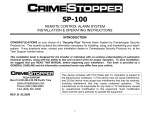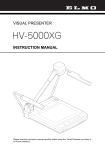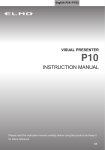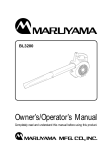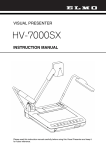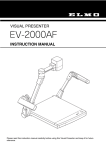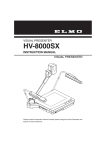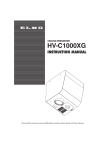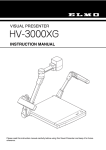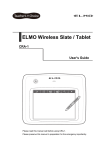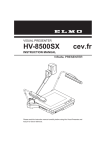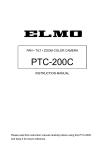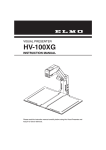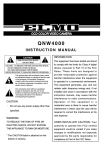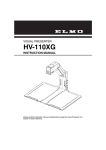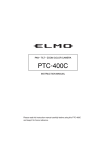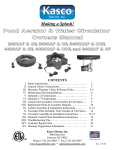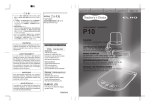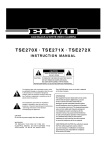Download Elmo EV 4400 AF Instruction manual
Transcript
VISUAL PRESENTER INSTRUCTION MANUAL Please read this instruction manual carefully before using this Visual Presenter and keep it for future reference. IMPORTANT SAFEGUARDS Read Instructions – All the safety and operating instructions should be read before the appliance is operated. Grounding or Polarization – This product may be equipped with either a polarized 2-wire AC line plug (a plug having one blade wider than the other) or a 3-wire grounding type plug, a plug having a third (grounding) pin. The 2-wire polarized plug will fit into the power outlet only one way. This is a safety feature. If you are unable to insert the plug fully into the outlet, try reversing the plug. If the plug still fails to fit, contact your electrician to replace your obsolete outlet. Do not defeat the safety purpose of the polarized plug. The 3-wire grounding type plug will fit into a grounding type power outlet. This is a safety feature. If you are unable to insert the plug into the outlet, contact your electrician to replace your obsolete outlet. Do not defeat the safety purpose of the grounding type plug. Retain Instructions – The safety and operating instructions should be retained for future reference. Heed Warnings – All warnings on the product and in the operating instructions should be adhered to. Follow Instructions – All operating and use instructions should be followed. Cleaning – Unplug this product from the wall outlet before cleaning. Do not use liquid cleaners or aerosol cleaners. Use a damp cloth for cleaning. Attachments – Do not use attachments not recommended by the product manufacturer as they may cause hazards. Power-Cord Protection – Power-supply cords should be routed so that they are not likely to be walked on or pinched by items placed upon or against them, paying particular attention to cords at plugs, convenience receptacles, and the point where they exit from the product. Water and Moisture – Do not use this product near water - for example, near a bath tub, wash bowl, kitchen sink, or laundry tub, in a wet basement, or near a swimming pool, and the like. Lightning – For added protection for this product during a lightning storm, or when it is left unattended and unused for long periods of time, unplug it from the wall outlet and disconnect the antenna or cable system. This will prevent damage to the product due to lightning and power-line surges. Accessories – Do not place this product on an unstable cart, stand, tripod, bracket, or table. The product may fall, causing serious injury to a child or adult, and serious damage to the product. Use only with a cart, stand, tripod, bracket, or table recommended by the manufacturer, or sold with the product. Any mounting of the product should follow the manufacturer's instructions, and should use a mounting accessory recommended by the manufacturer. Overloading – Do not overload wall outlets, extension cords, or integral convenience receptacles as this can result in a risk of fire or electric shock. A product and cart combination should be moved with care. Quick stops, excessive force, and uneven surfaces may cause the product and cart combination to overturn. Ventilation – Slots and openings in the cabinet are provided for ventilation and to ensure reliable operation of the product and to protect it from overheating, and these openings must not be blocked or covered. The openings should never be blocked by placing the product on a bed, sofa, rug, or other similar surface. This product should not be placed in a built-in installation such as a bookcase or rack unless proper ventilation is provided or the manufacturer's instructions have been adhered to. Object and Liquid Entry – Never push objects of any kind into this product through openings as they may touch dangerous voltage points or short-out parts that could result in a fire or electric shock. Never spill liquid of any kind on the product. Power Sources – This product should be operated only from the type of power source indicated on the marking label. If you are not sure of the type of power supply to your home consult your appliance dealer or local power company. For products intended to operate from battery power, or other sources, refer to the operating instructions. Servicing – Do not attempt to service this product yourself as opening or removing covers may expose you to dangerous voltage or other hazards. Refer all servicing to qualified service personnel. 1 Damage Requiring Service – Unplug this product from the wall outlet and refer servicing to qualified service personnel under the following conditions: CAUTION RISK OF ELECTRIC SHOCK DO NOT OPEN When the power-supply cord or plug is damaged. CAUTION: If liquid has been spilled, or objects have fallen into the product. If the product has been exposed to rain or water. If the product does not operate normally by following the operating instructions. Adjust only those controls that are covered by the operating instructions as an improper adjustment of other controls may result in damage and will often require extensive work by a qualified technician to restore the product to its normal operation. TO REDUCE THE RISK OF ELECTRIC SHOCK, DO NOT REMOVE COVER (OR BACK). NO USER-SERVICEABLE PARTS INSIDE. REFER SERVICING TO QUALIFIED SERVICE PERSONNEL. The lightning flash with arrowhead symbol, within an equilateral triangle, is intended to alert the user to the presence of uninsulated "dangerous voltage" within the product's enclosure that may be of sufficient magnitude to constitute a risk of electric shock to persons. This marking is located at the bottom of product. If the product has been dropped or damaged in any way. SA 1965 When the product exhibits a distinct change in performance - this indicates a need for service. The exclamation point within an equilateral triangle is intended to alert the user to the presence of important operating and maintenance (servicing) instructions in the literature accompanying the product. Replacement Parts – When replacement parts are required, be sure the service technician has used replacement parts specified by the manufacturer or have the same characteristics as the original part. Unauthorized substitutions may result in fire, electric shock or other hazards. SA 1966 WARNING: TO REDUCE THE RISK OF FIRE OR ELECTRIC SHOCK, DO NOT EXPOSE THIS PRODUCT TO RAIN OR MOISTURE. Safety Check – Upon completion of any service or repairs to this product, ask the service technician to perform safety checks to determine that the product is in proper operating condition. Heat – The product should be situated away from heat sources such as radiators, heat registers, stoves, or other products (including amplifiers) that produce heat. THIS IS A CLASS A PRODUCT. IN A DOMESTIC ENVIRONMENT THIS PRODUCT MAY CAUSE RADIO INTERFERENCE IN WHICH CASE THE USER MAY BE REQUIRED TO TAKE ADEQUATE MEASURES. INFORMATION This equipment has been tested and found to comply with the limits for a Class A digital device, pursuant to Part 15 of the FCC Rules. These limits are designed to provide reasonable protection against harmful interference when the equipment is operated in a commercial environment. This equipment generates, uses, and can radiate radio frequency energy and, if not installed and used in accordance with the instruction manual, may cause harmful interference to radio communications. Operation of this equipment in a residential area is likely to cause harmful interference in which case the user will be required to correct the interference at his own expense. USER-INSTALLER CAUTION: Your authority to operate this FCC verified equipment could be voided if you make changes or modifications not expressly approved by the party responsible for compliance to Part 15 of the FCC rules. 2 BEFORE YOU USE Use the Visual Presenter under the rated electrical conditions. Do not leave the Presenter under direct sunlight or by heaters, or the Presenter may be discolored, deformed, or damaged. Do not place the Presenter in any humid, dusty, windy or vibrating location. Use the Presenter in the following environmental conditions: Temperature: 5°C~40°C (41°F~104°F) Humidity: 30%~85% (No condensation) Use a soft, dry cloth for cleaning. Do not use any volatile solvent, such as thinner or benzine. Do not directly point the camera lens into the sun, or the camera may be damaged. Caring for the batteries : · If the Presenter is not used for a long time, take out the batteries from the wireless remote control. · Do not use rechargeable Ni-Cd batteries. · Do not use new and old batteries, or batteries of different types together. · Do not try to recharge or short-circuit the batteries. 3 CONTENTS 1. PART NAMES AND FUNCTIONS · · · · · · · · · · · · · · · · · · · · · · · · · · 6 Appearance · · · · · · · Front Panel · · · · · · · Operation Panel · · · · · Rear Panel · · · · · · · · Wireless Remote Control · · · · · · · · · · · · · · · · · · · · · · · · · · · · · · · · · · · · · · · · · · · · · · · · · · · · · · · · · · · · · · · · · · · · · · · · · · · · · · · · · · · · · · · · · · · · · · · · · · · · · · · · · · · · · · · · · · · · · · · · · · · · · · · · · · · · · · · · · · · · · · · · · · · · · · · · · · · · · · · · · · · · · · · · · · · · · · · · · · · · · · · · · · · · · · · · · · · · · · · · 6 7 8 9 10 2. WIRELESS REMOTE CONTROL · · · · · · · · · · · · · · · · · · · · · · · · · · 11 Preparation · · · · · · · · · · · · · · · · · · · · · · · · · · · · · · · · · · · · · · · · · · · · · · · 11 3. MOUSE · · · · · · · · · · · · · · · · · · · · · · · · · · · · · · · · · · · · · · · · 12 4. SETTING UP · · · · · · · · · · · · · · · · · · · · · · · · · · · · · · · · · · · · · 13 Connection to the monitor TV · · · · · · · · · · · · · · · · · · · · · · · · · · · · · · · · · · · · · · 14 Connection to the composite video-in terminal · · · · · · · · · · · · · · · · · · · · · · · · · · · · · · · · · 14 Connection to the S video-in terminal · · · · · · · · · · · · · · · · · · · · · · · · · · · · · · · · · · · · · · 14 5. STORING THE PRESENTER · · · · · · · · · · · · · · · · · · · · · · · · · · · · ·15 6. OPERATION PROCEDURES · · · · · · · · · · · · · · · · · · · · · · · · · · · · ·16 Simple steps for presenting printed material · · · · · · · · · · · · · · · · · · · · · · · · · · · · · · 16 Simple steps for showing transparent material, such as overhead transparencies or slide film · · · · 17 Convenient use of the camera · · · · · · · · · · · · · · · · · · · · · · · · · · · · · · · · · · · · · 17 7. VARIOUS FUNCTIONS · · · · · · · · · · · · · · · · · · · · · · · · · · · · · · · · 18 Lighting · · · · · · · · · · · · · · · · · · · · · · · · · · · · · · · · · · · · · · · · · · · · · · · · · 18 Zoom · · · · · · · · · · · · · · · · · · · · · · · · · · · · · · · · · · · · · · · · · · · · · · · · · · 19 Input selection · · · · · · · · · · · · · · · · · · · · · · · · · · · · · · · · · · · · · · · · · · · · · · 20 Table of Video- and Audio-in/out Terminal Selections Electronic enlargement Color/B&W selection · Posi/Nega conversion · White Balance · · · · · Iris · · · · · · · · · · · Focus · · · · · · · · · · · · · · · · · · · · · · · · · · · · · · · · · · · · · · · · · · · · · · · · · · · · · · · · · · · · · · · · · · · · · · · · · · · · · · · · · · · · · · · · · · · · · · · · · · · · · · · · · · · · · · · · · · · · · · · · · · 20 · · · · · · · · · · · · · · · · · · · · · · · · · · · · · · · · · · · · · · · · · · · · · · · · · · · · · · · · · · · · · · · · · · · · · · · · · · · · · · · · · · · · · · · · · · · · · · · · · · · · · · · · · · · · · · · · · · · · · · · · · · · · · · · · · · · · · · · · · · · · · · · · · · · · · · · · · · · · · · · · · · 21 22 22 23 23 24 Auto Focus · · · · · · · · · · · · · · · · · · · · · · · · · · · · · · · · · · · · · · · · · · · · · · · · · · · 24 Powered Manual Focus · · · · · · · · · · · · · · · · · · · · · · · · · · · · · · · · · · · · · · · · · · · · · 25 About the preset and move operation · · · Mouse pointer · · · · · · · · · · · · · · · · LCD monitor bracket socket · · · · · · · · · Connecting to the LCD monitor out terminal · · · · · · · · · · · · · · · · 4 · · · · · · · · · · · · · · · · · · · · · · · · · · · · · · · · · · · · · · · · · · · · · · · · · · · · · · · · · · · · · · · · · · · · · · · · · · · · · · · · · · · · · · · · · · · · · · · · · · · · · · · · 25 26 27 27 8. OSD (On-Screen-Display) · · · · · · · · · · · · · · · · · · · · · · · · · · · · · · 28 Color adjustment <CHROMA> · · · · · · · · · · · Electronic shutter <SHUTTER> · · · · · · · · · · Microphone input <MIC> · · · · · · · · · · · · · · AGC (Auto gain control) · · · · · · · · · · · · · · Adjusting the detail (Outline-accent function) · · · Setting the color of the mouse pointer · · · · · · · Electronic zoom ON/OFF selection · · · · · · · · Remote setting · · · · · · · · · · · · · · · · · · · Selection of preset No. and move No. <MEMORY> · · · · · · · · · · · · · · · · · · · · · · · · · · · · · · · · · · · · · · · · · · · · · · · · · · · · · · · · · · · · · · · · · · · · · · · · · · · · · · · · · · · · · · · · · · · · · · · · · · · · · · · · · · · · · · · · · · · · · · · · · · · · · · · · · · · · · · · · · · · · · · · · · · · · · · · · · · · · · · · · · · · · · · · · · · · · · · · · · · · · · · · · · · · · · · · · · · · · · · · · · · · · · · · · · · · · · · · · · · · · · · · · · · · · · · · · · 29 29 30 30 30 31 31 31 32 9. RS-232C SPECIFICATIONS · · · · · · · · · · · · · · · · · · · · · · · · · · · · · 33 Setting up · · · · · · · · · · · · · · · · · · · · · · · · · · · · · · · · · · · · · · · · · · · · · · · · Cable connection · · · · · · · · · · · · · · · · · · · · · · · · · · · · · · · · · · · · · · · · · · · · RS-232C connector specifications (DSUB-9P) · · · · · · · · · · · · · · · · · · · · · · · · · · · · · Table of the communication commands · · · · · · · · · · · · · · · · · · · · · · · · · · · · · · · · Data format specifications · · · · · · · · · · · · · · · · · · · · · · · · · · · · · · · · · · · · · · · Trasnmission Command (PC Visual Presenter) Responce data format (Visual Presenter PC) 33 34 34 35 37 · · · · · · · · · · · · · · · · · · · · · · · · · · · · · · · 37 · · · · · · · · · · · · · · · · · · · · · · · · · · · · · · · · 37 Transmission specifications · · · · · · · · · · · · · · · · · · · · · · · · · · · · · · · · · · · · · · · 38 Connection · · · · · · · · · · · · · · · · · · · · · · · · · · · · · · · · · · · · · · · · · · · · · · · 38 10. TROUBLESHOOTING HINTS · · · · · · · · · · · · · · · · · · · · · · · · · · · 39 Replacement of fluorescent lamp · · · · · · · · · · · · · · · · · · · · · · · · · · · · · · · · · · · · 39 11. SPECIFICATIONS · · · · · · · · · · · · · · · · · · · · · · · · · · · · · · · · · · 40 General · · · · · · · Main camera · · · · Lighting · · · · · · · Supplied accessories Options · · · · · · · · · · · · · · · · · · · · · · · · · · · · · · · · · · · · · · · · · · · · · · · · · · · · · · · · · · · · · · · · · · · · · · · · · · · · · · · · · · · · · · · · · · · · · · · · · · · · · · 5 · · · · · · · · · · · · · · · · · · · · · · · · · · · · · · · · · · · · · · · · · · · · · · · · · · · · · · · · · · · · · · · · · · · · · · · · · · · · · · · · · · · · · · · · · · · · · · · · · · · · · · · · · · · · · · · · · · · · · · · · · · · · · · · · · · · · · · · 40 41 42 42 42 1. PART NAMES AND FUNCTIONS Appearance 3. Camera Head 13. Infrared Sensor 7. Lighting Unit Arm 6. Lighting Unit 4. Close-up Lens Holder 2. Column (Attach this holder for normal use. Swing away this holder for viewing a far-away object.) 5. Column Lock Rerease Button Press this button to raise/fold the column. 7. Lighting Unit Arm 6. Lighting Unit 10. Carryng Handle 12. Power Switch 14. Mic Jack (MIC) 1. Stage 11. LCD Monitor Bracket Socket 8. Front Panel 9. Operation Panel (Usually, this panel is kept inside the main body. When the PUSH part is pushed, this panel becomes ready for operation.) 15. Wireless Remote Control 6 16. Scroll Mouse Front Panel 17. Lamp Buttons 18. Zoom Buttons 19. Auto Focus Button 17 Name Lamp Buttons Function To turn ON/OFF the lighting. 18 Zoom Buttons To change the image size. 19 Auto Focus Button To focus automatically (One-shot auto focus). (FOCUSFREE) 7 Reference Page P.17, P.18 P.16, P.19, P.24 P.16, P.24 Operation Panel 27. Menu Button 23. Posi/Nega Conversion Button 21. Magnification Button 20. Input Selection Buttons 26. Focus Buttons 25. Iris Buttons 24. White Balance Button 22. Color/B&W Selection Button 20. Name Input Selection Buttons Function To change the input line. 21. Magnification Button To double the image size. P.21 22. Color/B&W Selection Button To present black-and-white material, such as documents. P.22 23. Posi/Nega Conversion Button To show negative films. 24. White Balance Button Auto/One-Push To change the mode between AUTO and ONE-PUSH. 25. Iris Buttons To adjust the brightness of the screen. When the OSD menu is in display, these buttons function as the direction keys [ 26. Focus Buttons ] and [ P.17, P.22 To adjust focus (powered). When the OSD menu is in and [ Menu Button P.23 P.23, P.28 ]. display, these buttons function as the direction keys [ 27. Reference Page P.20 P.24, P25, P.28 ] ]. To display the OSD (On-Screen Display) menu. 8 P.28 Rear Panel 30. 12VDC Out Terminal [DC12V] 31. Mouse Terminal [MOUSE] 28. Power Cord Receptacle [AC IN] AC IN DC12V POWER 38. Audio-out Terminal [OUTPUT·AUDIO] 33. Video-in Terminal1 S-Video (mini DIN 4P) Composite video (RCA pinjack) [INPUT·AV1·S-VIDEO/VIDEO] 35. Audio-in Terminal1 [INPUT·AV1·AUDIO] ON OUTPUT INPUT MOUSE S-VIDEO VIDEO L AUDIO R AV1 S-VIDEO VIDEO L AUDIO R AV2 VIDEO L AUDIO R RS-232C OFF 29. Power Switch [POWER] 32. RS-232C Terminal [RS-232C] S-VIDEO VIDEO 36. Audio-in Terminal2 [INPUT·AV2·AUDIO] 39. Ext. Sync. Input Terminal [GEN-LOCK] 37. Video-out Terminal S-Video (mini DIN 4P) Composite video (RCA pinjack&BNC) [OUTPUT·S-VIDEO/VIDEO] 34. Video-in Terminal2 S-Video (mini DIN 4P) Composite video (RCA pinjack) [INPUT·AV2·S-VIDEO/VIDEO] Name GEN-LOCK Function Reference Page 28. Power Cord Receptacle [AC IN] Connected to the power cord connector. 29. Power Switch [POWER] To turn ON/OFF the power supply. P.16 30. 12VDC Out Terminal [DC12V] To output 12VDC. Can be connected to the LCD monitor (LM-5011N) (option) by using the LCD monitor connection cable (attached). P.27 31. Mouse Terminal [MOUSE] To connect the mouse (supplied accessory). P.12 32. RS-232C Terminal [RS-232C] Controllable from a general-purpose personal computer. P.33 33. Video-in Terminal1 [INPUT·AV1·S-VIDEO/VIDEO] S-Video (mini DIN 4P) Composite video (RCA pinjack) Video signal from this terminal is output through the video-out terminal when input selection is set at AV1. P.20 34. Video-in Terminal2 [INPUT·AV2·S-VIDEO/VIDEO] S-Video (mini DIN 4P) Composite video (RCA pinjack) Video signal from this terminal is output through the video-out terminal when input selection is set at AV2. P.20 35. Audio-in Terminal1 [INPUT·AV1·AUDIO] Audio signal from this terminal is output through the audio-out terminal when input selection is set at AV1. - 36. Audio-in Terminal2 [INPUT·AV2·AUDIO] Audio signal from this terminal is output through the audio-out terminal when input selection is set at AV2. - 37. Video-out Terminal Connected to a TV monitor or the like. [OUTPUT·S-VIDEO/VIDEO] S-Video (mini DIN 4P) Composite video (RCA pinjack&BNC) 38. Audio-out Terminal [OUTPUT·AUDIO] Connected to a TV monitor audio-input terminal or the like. - 39. Ext. Sync. Input Terminal [GEN-LOCK] To input external synchronizing signal. - 9 - P.14 Wireless Remote Control 40. IRIS OPEN 48. LAMP 41. IRIS CLOSE 49. MOVE 42. IRIS NORMAL 50. PRESET 43. FOCUS NEAR 44. FOCUS FAR 45. ZOOM TELE 46. ZOOM WIDE 47. INPUT 51. AF 40 Button Name IRIS OPEN Function Reference Page P.23 To open the AUTO iris. 41 IRIS CLOSE To close the AUTO iris. P.23 42 IRIS NORMAL To reset the AUTO iris to the initial value. P.23 43 FOCUS NEAR To move the focus near. P.24, P.25 44 FOCUS FAR To move the focus far. P.24, P.25 45 ZOOM TELE To zoom in. P.16, P.19, P.24 46 ZOOM WIDE To zoom out. P.16, P.19 47 INPUT To change the input system. P.20 48 LAMP To turn ON/OFF the lamp. P.17, P.18 49 MOVE To call the operating status of the Presenter saved in P.25 [PRESET]. 50 PRESET To save the operating status of the Presenter. 51 AF To focus automaticaly. 10 P.26 P.16, P.24 2. WIRELESS REMOTE CONTROL Point the infrared emitting part of the wireless remote control unit at the infrared sensor of the Visual Presenter, located on the top of the column, and press the button for the desired function. The receivable range may be narrowed when the Presenter is placed under sunlight, near an inverter fluorescent lamp or in any other unfavorable surroundings. Depending on the conditions of fluorescent lamps, etc. the sensor may fail to receive the infrared light. In such a case, relocate the Presenter, or take other countermeasures. 30˚ 30˚ 30˚ 30˚ 30˚ 30˚ 30˚ 30˚ Receivable range Distance : Approx. 7 m (23 ft.) or less from the light receiving area to the front of the wireless remote control Angle : Approx. 30 degrees or less from the light receiving area to the front of the wireless remote control rightward, leftward, upward and downward, respectively Preparation Remove the battery case cover by pressing downward on the [ OPEN] mark part in the direction as indicated by the arrow. Install 2 pcs of batteries (type R03, AAA) into the case in the direction as indicated there. Note: Install the batteries with the right polarity. Note: Change the batteries once a year. Note: The batteries supplied with the Presenter are only for use in initially confirming the operation of the Presenter. It is not guaranteed that these batteries can work effectively for the indicated period. 11 3. MOUSE Connect the mouse to the mouse terminal on the rear panel. The mouse can control the display and operation of the OSD Menu screen, mouse pointer and the Electronic enlargement. <About the mouse operation in normal use> · Left button ................ To turn ON/OFF the mouse pointer. · Center button .......... To turn ON/OFF the OSD menu. · Mouse wheel ......... To scroll the enlarged screen up/down in electronic double enlargement. · Right button ............. To turn ON/OFF the electronic double enlargement. Reference Page · Electronic enlargement · Mouse pointer · Mouse functions in the OSD Menu screen display · Remote setting P.21 P.26 P.28 P.32 Note: When using the mouse, connect the mouse before turning ON the power supply to the Presenter. If the mouse is connected after turning ON the power supply to the Presenter, the mouse will not function. Note: Use the attached mouse. If a mouse on the market is used, the normal operation cannot be guaranteed. Note: The mouse pointer and the OSD menu cannot be concurrently turned ON. Note: Control by the mouse and control by the PC (via RS-232C) cannot be concurrently used. To use the mouse, select <MOUSE> in the remote setting of the OSD menu. 12 Mouse Right button Left button Center button Mouse wheel 4. SETTING UP (1) Unfold the lighting unit arms fully until they come to the deadend. Unfold arm 1 and then arm 2 as illustrated. (2) Press the column lock release button, and raise the column until the column lock release button returns to the original position. Make sure that the column has been completely locked. (3) Turn the main camera head as illustrated until it is stopped. (4) Turn the main camera head until the lens faces to the stage. (5) Plug the power cord into the power cord receptacle of the Presenter and the AC outlet. 13 Connection to the monitor TV Note: Be sure to turn OFF the power supply to all equipment before making any connections to protect the Presenter and all the connected equipment. Note: Hold the cable plug part when connecting or disconnecting the cables. Connection to the composite video-in terminal Use the supplied RCA video/audio cable or a BNC cable available on the market. (Either the RCA jack or the BNC jack can be used.) AC IN DC12V POWER ON OUTPUT INPUT MOUSE S-VIDEO VIDEO L AUDIO R AV1 S-VIDEO VIDEO L AUDIO R AV2 VIDEO Monitor TV L AUDIO R RS-232C OFF S-VIDEO VIDEO GEN-LOCK Connection to the S video-in terminal Connect the S video-out terminal (mini DIN 4P) of the Presenter to the S video-in terminal of the TV/video monitor. For the S video mode, use an S video connection cable available on the market. If the equipment to be used is provided with a Y/C separate connector, a conversion adapter is necessary. AC IN DC12V POWER ON OUTPUT INPUT MOUSE S-VIDEO VIDEO L AUDIO R AV1 S-VIDEO VIDEO L AUDIO R AV2 VIDEO L AUDIO R RS-232C OFF 14 S-VIDEO VIDEO GEN-LOCK Monitor TV 5. STORING THE PRESENTER (1) Turn OFF the power switch, and unplug the power cord and the video cable. (2) Turn the main camera head as illustrated until it is stopped. Note: Be sure to set the camera head in the illustrated position before storing. Storing the main camera head in any other position may damage the stage surface or the lens. (3) Press the column lock release button, and fold down the main column. Note: The illustration shows the right storage position of the column. Never apply excessive force to the column. (4) Fold down the lighting unit arms 5 and 6. Be sure to fold down arm 5 first as per the illustration. 15 6. OPERATION PROCEDURES Simple steps for presenting printed material (1) Turn ON the power switch. Note: Before turning ON the power switch, connection to the monitor should have been completed. Note: When the power switch is turned ON, the lighting unit lights up. Note: If the power switch is turned ON immediately after being turned OFF, the Presenter may not operate. For restarting, turn ON the power switch several seconds after turning OFF. (2) Place the object on the stage. Adjust the image size according to the object size using the zoom buttons ([TELE]/[WIDE]) on the front panel or the zoom buttons ([TELE]/[WIDE]) on the wireless remote control, while watching the image on the TV monitor. Front panel Wireless remote control (3) Press the auto focus button [AUTO FOCUS] on the front panel or the auto focus button [AF] on the wireless remote control. Front panel Note: The auto focus function works up to a height of approx. 15cm (5.9 in.) above the stage surface (when the close-up lens is attached). Wireless remote control 16 Simple steps for showing transparent material, such as overhead transparencies or slide film Front panel (1) Press the base button [BASE] on the front panel or the lamp button [LAMP] on the wireless remote control to light up the base light (transparent lighting unit) built in the stage. Wireless remote control (2) To present a nega film, press the posi/nega conversion button [POSI/NEGA] on the operation panel to change the mode to [N] (Negative). Operation panel (3) To turn OFF the base light, press the base button [BASE] on the front panel or the lamp button [LAMP] on the wireless remote control again. Front panel Wireless remote control Convenient use of the camera Set the main camera head horizontally to shoot the objects, such as walls and distant views. When the object is far away, open the close-up lens holder to your side. Reference The focus can be achieved from 0.5m (20 in.) to ∞. Close-up lens holder 17 7. VARIOUS FUNCTIONS Lighting The upper lighting unit for presenting material such as printed matter and 3-D objects, and the baselight for presenting transparent material, such as slide, and negative films, are built in to the Presenter. When the lamp button [LAMP] ([UPPER]/[BASE]) on the front panel or the lamp button [LAMP] on the wireless remote control is pressed, the fluorescent lamp lights up in 1 to 3 seconds. Every time the lamp button [LAMP] on the wireless remote control is pressed, lighting is switched in a cycle of the lighting unit lights up the base light lights up the base light goes out. The lighting unit lights up when the power supply is turned ON. To turn OFF the lamp, press the button for the respective lamp. Note: It is impossible to have the upper lighting unit and the baselight lit up together. Note: When the lightness of the material surface is not sufficiently high or a 3-D object is presented, a sharp image with good color rendering can be obtained with the upper lighting unit on. 18 Front panel Wireless remote control Zoom Press the zoom button [TELE] on the front panel or wireless remote control, and the image will gradually be enlarged. Front panel Note: The image quality is lower within the electronic zoom range. For some material (objects), Wireless remote control horizontal stripes may be conspicuous. Front panel Press the zoom button [WIDE] on the front panel or wireless remote control, and the image will gradually be reduced. Reference Page · Electronic zoom ON/OFF selection P.31 Wireless remote control 19 Input selection Operation panel The respective images from two different AV sources such as a VCR and a video camera can be alternately presented on a monitor by selecting the AV source by pressing the desired input selection buttons without changing cable connections. The input can be switched by pressing the input select button [AV1] or [AV2] on the operation panel or the input select button [INPUT] on the wireless remote control. The lighting of the indicator lamp indicates which input is now selected. Every time the input selection button [INPUT] on the wireless remote control is pressed, input is switched in a cycle of the Main AV1 AV2. Input selection is possible as shown in the table on the next page. Signal change, such as "from C-video input to Svideo output" is not available. Wireless remote control Table of Video- and Audio-in/out Terminal Selections Audio-out terminal Video-out terminal Output signal S-VIDEO terminal RCA terminal BNC L terminal R terminal INTERNAL Main camera S-video signal Main camera C-video signal Main camera C-video signal Main body input microphone audio (monaural) Main body input microphone audio (monaural) AV1 AV1 input S-video signal AV1 input C-video signal AV1 input C-video signal AV1 input external audio AV1 input external audio signal L channel (stereo) signal R channel (stereo) + + Main body input microphone Main body input microphone audio (monaural) audio (monaural) AV2 AV2 input S-video signal AV2 input C-video signal AV2 input C-video signal AV2 input external audio AV2 input external audio signal L channel (stereo) signal R channel (stereo) + + Main body input microphone Main body input microphone audio (monaural) audio (monaural) Input 20 Electronic enlargement To double the image. To double the central part of the image, press the button [MAGNIFICATION] on the operation panel. When double magnification is selected, the indicator lamp lights up. The image can be enlarged only within the shooting area of the main camera. The mouse can be operated as follows: · Left button ................ To turn ON/OFF the scroll of the enlarged screen. When this button is pressed, "+" is displayed in the screen. When the mouse is dragged with this button held down, the enlarged screen scrolls. When the OSD Main menu is in display, the OSD screen is not in display but the mouse pointer is in display. · Center button .......... To turn ON/OFF the OSD Menu screen. · Mouse wheel ......... To scroll up/down the enlarged screen. · Right button ............. To turn ON/OFF the double enlargement. Note: When the electronic enlargement is tried while the mouse pointer is in display, as the left button of the mouse is limited to the scroll ON/OFF function, the mouse pointer cannot be turned OF/OFF. To turn ON/OFF the mouse pointer, turn OFF the electronic enlargement. Note: When the electronic zoom is ON and on the maximum telephoto side, even if the electronic enlargement button [MAGNIFICATION] is pressed, the image cannot be further enlarged. 21 Operation panel Color/B&W selection To present the B&W (Black&White) material such as documents. Sharper image with no color blur on the monitor can be produced. Set to color mode for normal use. Press the color/B&W selection button [COLOR/B&W] on the operation panel, the indicator lamp lights up and the mode changes to B&W mode. When the color/B&W selection button [COLOR/B&W] is pressed again, the indicator lamp goes out and the normal (COLOR) mode is resumed. Operation panel Posi/Nega conversion To show a negative film. Press the posi/nega conversion button [POSI/NEGA] on the operation panel or wireless remote control, the indicator lamp lights up and the image will be converted accordingly. When the posi/nega conversion button [POSI/NEGA] is pressed again, the indicator lamp goes out and the normal mode is resumed. 22 Operation panel White balance The camera of the Presenter automatically adjusts the shooting color balance (AUTO mode). However, depending on the color arrangement of document or the like, this color balance may be lost. In such case, shoot the stage surface, and press the white balance button [WHITE BALANCE] on the operation panel. Then, the indicator lamp blinks and then lights up, the mode is switched to the ONE-PUSH mode, and the white balance is fixed. When the white balance button [WHITE BALANCE] is pressed again, the indicator lamp goes out, and the mode returns to the AUTO mode. AUTO................... To set the white balance in the auto follow mode (initial setting). ONE-PUSH ......... To set the push-set white balance. By pressing the button [WHITE BALANCE], the white balance for the then color temperature is fixed. Operation panel Note: The automatically followed color temperature ranges from approx. 3000k to 8000k. Iris To adjust the Auto iris level of the lens. Press the iris button [OPEN] on the operation panel or the iris open button [IRIS OPEN] on the wireless remote control, and the iris will open. Press the iris button [CLOSE] on the operation panel or the iris close button [IRIS CLOSE] on the wireless remote control, and the iris will close. Press the iris normal button [IRIS NORMAL] on the wireless remote control, and the initial setting will be resumed. Note: If the screen looks dark, press the iris button [IRIS OPEN] on the wireless remote control to adjust the brightness of the screen. 23 Operation panel Wireless remote control Focus Auto Focus Press the auto focus button [AUTO FOCUS] on the front panel or the auto focus button [AF] on the wireless remote control, and the auto-focus will be activated. While the auto-focus is in operation, the indicator lamp on the front panel blinks until the object is brought into focus. Front panel Wireless remote control The Presenter features a one-push auto focus function. Once focusing is completed, the auto focus function is released, and the focused position maintains unchanged (FOCUSFREE). To obtain sharper image, zoom in on the object by pressing the zoom button [TELE] on the front panel or wireless remote control and press the auto-focus botton. However, the objects listed below may not be brought into focus in the auto focus mode. In these cases, use the manual focus mode. · Objects bearing little contrast · Objects with fine repeated patterns, such as lateral stripes and cross stripes · Objects glittering or reflecting strong light · Objects with bright background, or excessive contrast · Objects in a dark picture plane · Objects located near and far away at the same time · Objects in motion If the focus button [NEAR] or [FAR] on the front panel or the focus button [FOCUS NEAR] or [FOCUS FAR] on the wireless remote control is pressed during the auto focus, the auto focus will be released. Front panel Wireless remote control Operation panel Note: The auto focus functions up to approx. 15cm (5.9 in.) above the stage surface (with the close-up lens attached). 24 Wireless remote control Operation panel Powered Manual Focus To focus on specific part of the material, such as 3-D material. Press the focus button [NEAR] or [FAR] on the operation panel or the focus button [FOCUS NEAR] or [FOCUS FAR] on the wireless remote control. Note: The manual focus works up to approx. 15cm Wireless remote control (5.9 in.) above the stage surface (with the closeup lens attached). About the preset and move operation The Presenter has a function of saving its operation status (Preset). The preset function is available in 2 ways read by the move button [MOVE] and 1 way automatically read upon turning ON the power supply for startup. The operation status that can be saved includes: · Present zoom angle of view · Adjustment status of AUTO iris level · White balance mode · Lighting status · Posi/Nega selection status · Color/B&W selection status · Electronic enlargement ON/OFF status · Screen scroll position when electronic enlargement is selectedP 1. How to move Display the OSD, select <MAIN MENU> <MEMORY> <MOVE NUM.> in this order, and select "1" or "2" whichever you want to read. Close the status or the OSD and press the move button [MOVE] on the wireless remote control, and the Presenter will be set to the status saved in the selected number. No. "1" has been selected on the status of factory setting. Monitor screen MEMORY PRESET NUM. MOVE NUM. Wireless remote control 25 1 1 2. How to preset <Presetting by reading by pressing the move button [MOVE] on the wireless remote control> Display the OSD, select <MAIN MENU> <MEMORY> <PRESET NUM.> in this order, and select "1" or "2" whichever you want to save. Close the status or the OSD and then press the preset button [PRESET], and the present operating status will be saved in the selected No. "1" has been selected on default. <Presetting by automatically reading upon turning ON the power supply> In the same way as "Presetting by reading by pressing the move button [MOVE] on the wireless remote control", open the OSD menu, and select "0." Close the status or the OSD and press the preset button [PRESET] on the wireless remote control, and the present operating status of the Presenter will be saved, and called upon turning ON the power supply next time. Monitor screen MEMORY PRESET NUM. MOVE NUM. Wireless remote control Wireless remote control Mouse pointer When the left button on the mouse is clicked, the mouse pointer appears. When the mouse is moved, the mouse pointer moves accordingly. When the left button on the mouse is clicked while the mouse pointer is on the screen, the mouse pointer disappears. 26 Mouse Appear/disappear 1 1 LCD monitor bracket socket The LCD monitor bracket socket is used for attaching an LCD monitor (optional) with an LCD monitor bracket (optional). For the connection method refer to the instruction manual of the LCD monitor. LCD Monitor Note: This Presenter (EV-4400AF) is not accompanied by the LCD monitor or the LCD monitor bracket. These are available on option. LCD Monitor bracket socket LCD Monitor bracket Connecting to the LCD monitor out terminal The LCD monitor (LM-5011N) can be connected by using the LCD monitor out terminal of the Presenter. Note: When connecting to the LCD monitor out terminal, confirm the right connection direction. DC IN 12V + - VIDEO IN Note: When using the LCD monitor connection cable, do not use the AC adapter or video cable attached to the LCD monitor (LM-5011N). Note: The LCD monitor (LM-5011N) and the LCD monitor bracket are available on option, and not attached to this Presenter (EV4400AF). LCD monitor connection cable (accessory) 27 LCD monitor out terminal 8. OSD (On-Screen Display) When the menu button [MENU] on the front panel or the center button of the mouse is pressed, the OSD Setting Main menu <MAIN MENU> is displayed. Choose the item of each function in the main menu. Operation panel <How to adjust the OSD on the operation panel> 1. Select the menu to be adjusted by using the [ ] and [ ] buttons, and fix the selection by using the [ ] button. Then, the Sub menu is displayed. 2. Select the item to be adjusted by using the [ ] and [ ] buttons, and adjust the value by using the [ ] and [ ] buttons. 3. After adjustment, press the menu button [MENU] to return to the Main menu <MAIN MENU>. Then, press the menu button [MENU] again, and the OSD screen will close. The adjusted value is saved when the main menu <MAIN MENU> closes, and reflected on the next rebooting. (To return the adjusted value to the default value, select [DEFAULT] in the Main menu <MAIN MENU>, and press the [ ] button.) <Mouse functions in the OSD Menu screen display> · Left button ................ Equivalent to the [ ] button on the operation panel (ADJUST function). When the Main menu is in display, the OSD screen is not in display but the mouse pointer is in display. · Center button .......... Equivalent to the menu button [MENU] on the operation panel (END function). · Mouse wheel ......... Equivalent to the [ ] and [ ] buttons on the operation panel (SELECT function). · Right button ............. Equivalent to the [ ] button on the operation panel (ENTER and ADJUST functions). 28 Main menu (in the monitor) MAIN MENU CHROMA SHUTTER MIC OPTION MEMORY [ DEFAULT ] Operation panel Color adjustment <CHROMA> · Menu sequence <MAIN MENU> <CHROMA> To adjust the color of the video output image of the main camera. Switching of AUTO MANUAL is available. (Initial setting : <AUTO>) (Adjustable range : Initial value <0>) Functions Menu displayed R-GAIN Adjustable range To adjust color gain (color depth) of -128 to 127 the red component. B-GAIN To adjust the color gain of the blue Monitor screen CHROMA MODE MANUAL R-GAIN 0 B-GAIN 0 R-PHASE 0 G-PHASE 0 B-PHASE 0 Ye-PHASE 0 -128 to 127 component. R-PHASE To adjust the hue (tint) of the red -128 to 127 component. G-PHASE To adjust the hue (tint) of the green -128 to 127 component. B-PHASE To adjust the hue (tint) of the blue -128 to 127 component. Ye-PHASE To adjust the hue (tint) of the yellow -128 to 127 component. Electronic shutter <SHUTTER> · Menu sequence <MAIN MENU> Monitor screen <SHUTTER> To set the shutter speed. SHUTTER Menu displayed <SPEED> SPEED FL Functions To change the shutter speed to: OFF 1/100s 1/500s 1/1000s (Initial setting : <OFF>) <FL> 60Hz 50Hz In the areas with power frequency of 50Hz, flicker phenomenon may occur when the Presenter is used with the mode <60Hz> lighting of discharging tubes, such as fluorescent lamps and mercury lamps. Set to the mode <50Hz> before use. In areas with power frequency of 60Hz, leave the Presenter in the mode <60Hz>. (Initial setting : <60Hz>) Note: In the mode <SPEED>, flickering or color shimmering may occur. In this case, select slower shutter speed. 29 OFF 60Hz Microphone input <MIC> · Menu sequence <MAIN MENU> Monitor screen <MIC> To set the volume of sound from the Mic Jack. Menu displayed VOLUME MIC VOLUME MUTE Functions 42 OFF To set the volume of monaural sound from the Mic Jack. (0 to 64) (Initial value : <42>) MUTE To set the volume of sound from the Mic Jack to zero. (Initial setting : <OFF>) Note: If the input selection is set to anything other than [MAIN], the sound will be output from the Mic audio output terminal. AGC (Auto gain control) · Menu sequence <MAIN MENU> <OPTION> <AGC> To set the auto gain control. When the object is dark, The AGC can gain up the image of the object to be lighter. (Initial setting : <AUTO>) Menu displayed Functions <OFF> No gain-up (initial setting) <3dB, 6dB, 10dB> To select gain-up from among 3 levels Monitor screen OPTION AGC DETAIL POINTER E. ZOOM REMOTE OFF 0 WHITE ON MOUSE Adjusting the detail (Outline-accent function) · Menu sequence <MAIN MENU> <OPTION> To adjust the contour intensity in a range from -5 to 5. (Initial setting : <0>) <DETAIL> Monitor screen OPTION AGC DETAIL POINTER E. ZOOM REMOTE 30 OFF 0 WHITE ON MOUSE Setting the color of the mouse pointer · Menu sequence <MAIN MENU> <OPTION> <POINTER> In <POINTER>, the color of the pointer is changed by using the direction button [ ][ ]. (2 colors: WHITE BLACK) (Initial setting : <WHITE>) Monitor screen OPTION AGC DETAIL POINTER E. ZOOM REMOTE OFF 0 WHITE ON MOUSE Electronic zoom ON/OFF selection · Menu sequence <MAIN MENU> <OPTION> <E. ZOOM> The ON/OFF status of the electronic zoom can be changed. (Initial setting : <ON>) Monitor screen OPTION AGC DETAIL POINTER E. ZOOM REMOTE OFF 0 WHITE ON MOUSE Remote setting · Menu sequence <MAIN MENU> <OPTION> <REMOTE> Select which equipment, the mouse <MOUSE> or the PC <PC>, should be used for controlling the Presenter. (Initial setting : <MOUSE>) Note: The setting becomes effective upon closing the OSD menu. It is not yet effective as of selection. 31 Monitor screen OPTION AGC DETAIL POINTER E. ZOOM REMOTE OFF 0 WHITE ON MOUSE Selection of preset No. and move No. <MEMORY> · Menu sequence <MAIN MENU> <MEMORY> <PRESET NUM.> Select the No. in which you want to save the operation status of the Presenter in PRESET. · Menu sequence <MAIN MENU> <MEMORY> <MOVE NUM.> Select the No. from which you want to call the operation status of the Presenter in MOVE. Reference Page · About the preset and move operation P.25 32 Monitor screen MEMORY PRESET NUM. MOVE NUM. 1 1 9. RS-232C SPECIFICATIONS The Presenter can be controlled by a PC connected to the Presenter through the RS-232C terminal [RS-232C]. Setting up (1) Open the OSD menu, select the <PC> setting by opening <MENU> and close the Menu screen. <OPTION> <REMOTE> in this order, Note: Upon selection, the mouse is no longer operable. (2) Connect the Presenter to a PC with an RS-232C connection cable. Note: When using an RS-232C cable available in the market, make sure of the connection shown the next page. Note: To protect the Presenter and the PC, be sure to turn OFF all the power switches of all equipment before connecting. (3) Start the PC, and set the communication mode of the RS-232C to the communication mode of the Presenter. Note: For the information how to set the communication mode of the RS-232C, refer to the instruction manual of the PC. (4) Start the PC program to operate the Presenter. (5) Control through the RS-232C will start. Note: For communication control, be sure to take the above steps for setting. 33 Cable connection PC side (DSUB-9P) Visual Presenter side (DSUB-9P) DSUB-9P (Female) 5 4 3 2 1 9 8 7 6 CD RXD TXD DTR SG DSR RTS CTS RI (CI) 1 2 3 4 5 6 7 8 9 1 2 3 4 5 6 7 8 9 PC side : DSUB-9P (Female) CD RXD TXD DTR SG DSR RTS CTS RI 5 4 3 2 1 9 8 7 6 RS-232C connector specifications (DSUB-9P) Pin No. Code Name Direction of data Visual Presenter PC Comments 1 CD Carrier Detect CD : Carrier Detect 2 RXD Received Data RXD : Received Data 3 TXD Transmitted Data 4 DTR Data Terminal Ready 5 SG Signal Ground SG 6 DSR Data Set Ready DSR : Data Set Ready 7 RTS Request To Send 8 CTS Clear To Send TXD : Transmitted Data DTR : Data Terminal Ready : Signal Ground RTS : Request To Send CTS : Clear To Send 34 Table of the communication commands Function Command Parameter Comments Data Auto Focus AF 0 Command to execute the one-step Auto Focus. Focus adjustment FO + (NEAR) - (FAR) 0 (STOP) Command to adjust the Focus. Zoom adjustment ZO + (TELE) - (WIDE) 0 (STOP) Command to adjust the Zoom. Iris adjustment IR + (OPEN) - (CLOSE) 0 (STOP) 1 (NORMAL) Command to adjust the Iris. Lighting selection PL 0 (OFF) 1 (BASE) 2 (UPPER) Command to select the Lighting. Input selection AV 0 (MAIN) 1 (AV1) 2 (AV2) Command to select the Input. Posi/Nega conversion NP 0 (POSI) 1 (NEGA) Command to convert Posi/Nega. Color/B&W selection CB 0 (COLOR) 1 (B&W) Command to select Color/B&W. Mouse Pointer display PO 0 (OFF) 1 (ON) Command to turn ON/OFF the Mouse pointer display. Mouse pointer movement PM 0 (STOP) 1( ) 2( ) 3( ) 4( ) 5( ) 6( ) 7( ) 8( ) · When the mouse pointer is ON The mouse pointer moves. · When the image enlargement is ON The enlarged image moves. 1: To the right side. 2: To the left side. 3: To the upper side. 4: To the lower side. 5: To the upper right. 6: To the upper left. 7: To the lower right. 8: To the lower left. Image enlargement MA 0 (OFF) 1 (ON) Command to enlarge the image to double the area around the mouse pointer position. 35 Function Command Parameter Comments Data Local lockout LL 0 (OFF) 1 (ON) Command to invalidate the switches on the front panel, operation panel and wireless remote control. Default DF 0 Command to reset to the initialized mode. Status request QS 0 Command to inquire the status of the equipment. ROM version QR 0 Command to refer to the ROM version. Acknowledge check SA 0 (OFF) 1 (ON) Command to select the command acknowledge for each operation command. Default is ON. Add CR command SC 0 (OFF) 1 (ON) Command to add CR [0Dh] to the end of the acknowledge data. Default is OFF. Note: " " in the data column means that SPACE [20H] should be transmitted twice. 36 Data format specifications This command is executed in the form of 1-command/1 packet. The next command is not accepted until the previous processing is completed. · The communication command always starts with STX (Start of Text) [02H], and ends with ETX (END of Text) [03H]. · If the communication format or command name is wrong, NAK (Negative Acknowledgement) [15H] will be sent from the Presenter as a result of failing to receive correctly. · When the communication format is correctly received, the Presenter sends ACK (Normal Acknowledgement) [06H]. Transmission Command (PC Visual Presenter) Each operation command is executed in ASCII code, and transmitted in a set of 7 bytes as follows: S T X (PC) Command Parameter E T X Data [02H] (Visual Presenter) [03H] ACK [06H] Response data format (Visual Presenter PC) Status request format (Parameter 0) Posi Lighting Input selection selection /Nega (Visual Presenter) S T X 1 2 Color /B&W 3 4 Pointer Image display enlargement 5 6 Local Lock out 30H 7 [02H] S T X E T X [03H] ROM version (Visual Presenter) 8 V F C N 56H 46H 43H 4EH [02H] E T X Version 37 [03H] Transmission specifications · · · · · · · Full duplex start-stop sync. mode Start bit Data bit Stop bit Parity bit X parameter Baud rate (Communication speed) : 1 bit : 8 bits : 1 bit : None : None : 9600bps Connection If the RS-232C cable is not correctly connected between the Presenter and the PC, no acknowledgement is transmitted. Connect the RS-232C cable correctly, and fix it firmly with the connector set screws before the operation. 38 10. TROUBLESHOOTING HINTS Symptom Possible cause/countermeasure No Images on TV monitor · · · · · · Out of focus · The object is too close to the lens. Check if it does not stand higher than 15cm (5.9 in.) above the stage surface. · Zoom is set at TELE after focusing at WIDE angle. Focus on the point of max. TELE. · In the auto-focus, focusing is difficult in some cases. The lamp is not quickly turned ON. · For protection purposes, the lamp is turned ON after preheating for 2 seconds. This is not a fault. Image is too dark. · The intensity of illumination is not sufficient. Press the upper button [UPPER] on the front panel or the lamp button [LAMP] on the wireless remote control and turn ON the upper lamp. · The AUTO iris level is on the "CLOSE" side. Press the open button [OPEN] on the operation panel or the iris open button [IRIS OPEN] on the wireless remote control. Input selection can not be made. · Inputting to S-video while connecting output of C-video to the monitor or vice versa. (Refer to the "Table of Video -and Audio-in/out Terminal Selections" on P.20.) Cable is not properly connected to the video-in terminal of monitor. The power cord is disconnected from the wall AC outlet. The plug is disconnected from the power cord receptacle of the Presenter. The power switch is not turned ON. Zoom is set at TELE to display only white/black part of the material. The power switch is turned ON immediately after it is turned OFF. In this case, the Presenter may not start. Wait several seconds after turning OFF the power switch, and then turn ON the power switch. The image of printed matter is striped. · This is caused by the interference between the dots of printed matter and the scanning line. The image flickers. · The light from the discharge tube (50Hz) does not come to the screen. When <SHUTTER> is changed to <FL> and <50Hz> is selected in the OSD menu, the image flickering may be mitigated. (Refer to P.29.) If the trouble still remains after checking the above, consult your dealer or an authorized ELMO service center. Replacement of fluorescent lamp The lighting lamps (fluorescent lamps) are expendables. When any of them begins to shimmer or be less bright, replace it. Note: For the replacement of the lamp, consult your dealer from whom you have purchased your Visual Presenter or an authorized ELMO service center. 39 11. SPECIFICATIONS General Specifications Item Power source AC100V-240V 50Hz/60Hz Power consumption 0.5A-0.3A Outside dimensions 533mm (W) X 449mm (D) X 190mm (H) (21.0 X 17.7 X 7.5 in.) - When folded 766mm (W) X 449mm (D) X 602mm (H) (30.2 X 17.7 X 23.7 in.) - When set up Weight 10 kgs (main body only) Television system NTSC compatible Input selection Internal/External 2 systems Output terminal C-video output RCA pinjack/75 unbalanced BNC connector/75 Input terminal Ext. control terminal 1 unbalanced 1 LCD monitor connection terminal (Mini DIN 9P) 1 S-video output Mini DIN 4P connector/75 1 Audio output (stereo) RCA pinjack/applicable impedance 10k S-video input Mini DIN4P connector/75 C-video input RCA pinjack/75 Ext. sync. input BNC connector/75 Audio input (stereo) RCA pinjack/applicable impedance 10k Mic. input (monaural) 6.3mm jack/applicable impedance 600 RS-232C DSUB 9P connector male 1 Mouse Mini DIN 6P connector 1 40 unbalanced or more, -10dB 1 pair 2 unbalanced 2 unbalanced unbalanced 1 or more, -10dB -65dB 2 pairs 1 Main camera Specifications Item Lens f=4.7-84.6mm (Optical 18-time zoom) F2.1-2.4 Shooting area 420mm X 310mm (16.5 X 12.2 in.) max., 26mm x 20mm (1.0 X 0.8 in.) min. (13mm X 10mm (0.5 X 0.4 in.) when digitally zoomed) Limit of focus adjustment at the range of stage surface~150mm from the stage surface 0.5m-∞ (with the camera facing sideways and with no close-up lens) Zooming 36-time zoom (continuous zoom mode with automatic switching from the 18-time optical zoom plus electronic zoom with 2X function) Focusing Auto/manual (powered) Iris Auto (with level adjustment) Image pick-up element Interline-transfer 1/3" size color CCD Effective picture element 768 (H) x 494 (V) Total picture elements 811 (H) x 508 (V) Image signal processing Digital signal processing (DSP) Sync. system Internal/External sync. (automatic selection) Resolution More than 470 TV lines (Y signal with horizontal) More than 350 TV lines (Vertical) S/N ratio 48 dB (with adjusting the detail min.) Output signal C-video VBS 1.0 V (p-p)/75 unbalanced S-video Y 0.714 V (p-p)/75 C 0.286 V (p-p)/75 unbalanced unbalanced Ext. sync. frequency range SYNC H 15.734kHz Ext. sync. input condition VBS: (75 unbalanced) SYNC: 0.3V 0.1V, Burst: 0.3V 50ppm 0.1V White balance Full auto/One push Color gain control Provided Color phase adjustment Provided Electronic shutter speed FLC mode (60Hz Posi/Nega conversion Provided (C-video, Output to monitor, S-video) Color/B&W selection Provided (C-video,Output to monitor, S-video) AGC Selectable (OFF/3dB/6dB/10dB) Detail adjustment Provided Status preset Provided (Readable - 2 ways, Upon turning ON power supply for startup - 1 way) Electronic enlargement Provided (double, can be scrolled) Pointer Controllable by mouse or RS-232C. 2 selectable colors 50Hz)/SPEED (OFF 41 1/100s 1/500s 1/1000s) Lighting Specifications Item Upper High frequency lighting mode, 3-wave-length type fluorescent lamp 6W (Model:FHL6EX-N) Base High frequency lighting mode, 3-wave-length type fluorescent lamp Area size: 296mm (W) x 216mm (H) (11.7 x 8.5 in.) Supplied accessories Name Quantity Power cord (2.5m) 1 Video-audio cable (2m) 1 Scroll mouse 1 Infrared wireless remote controller (RCW-632) 1 Batteries (Type R03, AAA) 2 LCD monitor connection cable 1 Instruction manual for EV-4400AF 1 Options · 5" TFT LCD color monitor (Type LM-5011N), LCD monitor bracket (MS-500), preparation projector (MG-600) Note: For the TRCA pin, use a pin plug conformable to EIAJ RC-6703. Note: The specifications are subject to change without notice. Trademark Acknowledgements ELMO, FOCUSFREE are trademarks of ELMO CO.,Ltd. 42 WARNING: Unauthorized recording of copyrighted slide films, materials, photographs, etc. may infringe on the rights of copyright owners and be contrary to copyright laws. ELMO CO., LTD. 6-14, Meizen-cho, Mizuho-ku, Nagoya, 467-8567, Japan OVERSEAS SUBSIDIARY COMPANIES U.S.A. ELMO Mfg. Corp. 1478 Old Country Road, Plainview, NY 11803-5034 Tel:(516)501-1400 Fax:(516)501-0429 E-mail:[email protected] web:http://www.elmousa.com Canada ELMO Canada Mfg. Corp. 44 West Drive, Brampton, Ontario L6T 3T6 Tel:(905)453-7880 Fax:(905)453-2391 E-mail : [email protected] web:http://www.elmocanada.com Germany ELMO (Europe) G.m.b.H Neanderstr. 18, 40233 Düsseldorf Tel : (0211)376051 Fax : (0211)376630 E-mail : [email protected] web : http://www.elmo.de Printed in Japan 6X1VFCN02












































